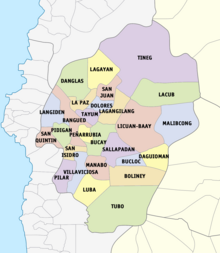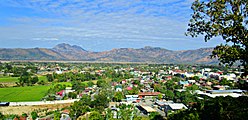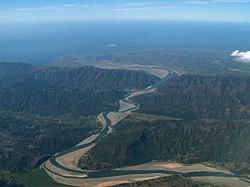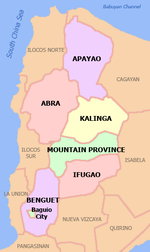Abra (province)
Abra | |
|---|---|
| Province of Abra | |
(from top: left to right)Bangued,Tayum Church,Abra Provincial Capitol,Bucay Casa Real,San QuintinandAbra River. | |
 Location in the Philippines | |
| Coordinates:17°35′N120°45′E/ 17.58°N 120.75°E | |
| Region | Cordillera Administrative Region |
| Founded | March 10, 1917 |
| Capital and largest municipality | Bangued |
| Government | |
| •Governor | Dominic B. Valera (NUP/ASENSO) |
| •Vice Governor | Maria Jocelyn V. Bernos(NUP/ASENSO) |
| •Legislature | Abra Provincial Board |
| Area | |
| • Total | 4,165.25 km2(1,608.21 sq mi) |
| • Rank | 29th out of 81 |
| Highest elevation | 2,467 m (8,094 ft) |
| Population (2020 census)[2] | |
| • Total | 250,985 |
| • Rank | 68th out of 81 |
| • Density | 60/km2(160/sq mi) |
| • Rank | 80th out of 81 |
| Divisions | |
| •Independent cities | 0 |
| •Component cities | 0 |
| •Municipalities | |
| •Barangays | 303 |
| •Districts | Legislative districts of Abra |
| Time zone | UTC+8(PHT) |
| ZIP code | 2800–2826 |
| IDD : area code | +63 (0)74 |
| ISO 3166 code | PH-ABR |
| Spoken languages | |
| Website | www |
Abra,officially theProvince of Abra(Ilocano:Probinsia ti Abra;Tagalog:Lalawigan ng Abra), is aprovincein theCordillera Administrative Regionof thePhilippines.Its capital is the municipality ofBangued.It is bordered byIlocos Norteon the northwest,Apayaoon the northeast,Kalingaon the mid-east,Mountain Provinceon the southeast, andIlocos Suron the southwest.
Etymology
[edit]Abra is from the Spanish wordabrameaning gorge, pass, breach or opening. It was first used by the Spaniards to denote the region above theBanaoang Gapwhere the Abra River exits into the West Philippine Sea, thus the Rio Grande de Abra.[3]
History
[edit]This sectionneeds expansion.You can help byadding to it.(December 2015) |
Early history
[edit]The first inhabitants of Abra were the ancestors of theBontocsand theIfugaos.These inhabitants eventually left to settle in the old Mountain Province. Other early inhabitants were theTinguians or Itnegs.
Spanish colonial era
[edit]In 1585, theTinguianswere mentioned for the first time in a letter fromFather Domingo de Salazarto the King of Spain.
In 1598Banguedwas occupied by Spanish-Iloco forces. The Spanish established a garrison to protect their missionaries from head hunters so that they could Christianize theTinguiansand locate gold mines. This led to the Ilocano settlement of this area.
Banguedwas under the care of the Spanish missions inViganandBantay.Fr. Esteban Marin and Fr. Agustin Minon established a mission inBanguedas early as 1598. On April 5, 1612, Fr. Pedro Columbo became the first minister. It would seem that this actuation of theAugustinianswas precipitated by theDominicantake-over of the ministry ofNarvacansince the Dominicans wanted to convert Narvacan into a mission center to evangelize the other parts of Abra. To check this Dominican move, the Augustinians elevated Bangued to a ministry.
Fr. Juan ParejaOSA,a former parish priest inBantay,led the conversion of the province. He came to Abra in 1626 and is reported to have converted as many as 3,000 inhabitants including the chieftain Miguel Dumaoal. He founded the mission of San Diego and later the ministry of Bangued. He established the following towns as visitas of Bangued:Tayum,Sabangan and Bucao (nowDolores). Inspired by Fr. Pareja these towns battled almost daily against the rancherias of Palang, Talamuy, Bataan, Cabulao, Calaoag, andLangiden.
Fr. Jose PolancoOPalso contributed to the conversion of Abra. A man of austere mortification, he died in Abra in 1679 and was considered a saint by the locals.
Fr. Bernardino LagoOSAarrived in the early 19th century. In 1823, Fr. Lago began work inPidigan.After 25 years the Christians were numbered about a thousand "baptized, living in community, with schools, church and municipal house, tilling the earth to support themselves and their children." Fr. Lago also founded the town ofLa Paz.Fr. Galende enumerates the foundation of the other towns of Abra:
- Tayum,1803
- San Gregorio, 1829
- Pidigan,1823
- La Paz,1832
- Bucay,1847
- San Jose, 1848
- Villavieja, 1862
- San Quintin,1868
- Dolores,1882
- Pilar,1882
- San Juan,1884
- Alfonso XII, 1884
Originally the area was calledEl Abra de Vigan( "The Opening of Vigan" ). During theBritish Occupation of the Philippines,Gabriela Silangand her army fled to Abra fromIlocosand continued the revolt begun by her slain husbandDiego Silang.She was captured and hanged by authorities in 1763.
In 1818, the Ilocos region was divided intoIlocos NorteandIlocos Sur.On October 9, 1846, Abra became an independent province with the capital and residence of the provincial governor located in Bucay. In 1863 the capital was transferred to Bangued, the province's oldest town. It remained so until the arrival of the Americans in 1899.
American invasion era
[edit]In 1908, thePhilippine Commissionannexed Abra into Ilocos Sur in an attempt to resolve Abra's financial difficulties. On March 9, 1917 thePhilippine Assemblyre-established Abra as a province under Act 2683.[4]
Japanese occupation era
[edit]In 1942 Japanese forces occupied the Philippines and seized Abra.[further explanation needed]
Abra was liberated by the Filipino soldiers and guerrillas including Allied forces liberated the province of Abra in 1945 at the end of theSecond World War.[further explanation needed]
This sectionneeds expansion.You can help byadding to it.(March 2016) |
Under the Marcos dictatorship
[edit]The beginning months of the 1970s marked a period of turmoil and change in the Philippines, as well as in Abra.[5]During hisbid to be the first Philippine president to be re-electedfor a second term, Ferdinand Marcos launched an unprecedented number of public works projects. This caused[6][7]the Philippine economy took a sudden downwards turn known as the1969 Philippine balance of payments crisis,which in turn led to a period of economic difficulty and social unrest.[8][9]: "43" [10][11]
With only a year left in his last constitutionally allowed term as president Ferdinand Marcos placed the Philippines underMartial Lawin September 1972 and thus retained the position for fourteen more years.[12]This period in Philippine history is remembered for the Marcos administration's record ofhuman rights abuses,[13][14]particularly targeting political opponents, student activists, journalists, religious workers, farmers, and others who fought against the Marcos dictatorship.[15]In Abra, many of the victims were from the indigenousItneg people(known then among most lowlanders as the Tingguian people, which is anexonym). Numerous human rights abuses against Itnegs were documented in the various Amnesty International missions which allowed to conduct investigations in the country after Marcos had to give in to political pressure.[16]
On May 6, 1983, Sitio Beew in theMunicipality of Tubowas the site of several attacks by the 623rd Philippine Constabulary (623rd PC) led by Captain Berido, Lt. Rehaldo Lebua and Lt. Juanito Puyawan, which would collectively come to be known as the "Beew massacre."The 623rd PC burned down four houses and a rice granary, which still contained the remains of three villagers including an unborn baby, and Barangay Councilman Rodolfo Labawig, pregnant mother Josefina Cayandag, and her unborn child.[17]Beew residents,including babies and toddlers, were beaten and their houses looted in response to the residents' alleged support of protests against the logging operations ofHerminio Disini'sCellophil Resources Corporationin their area.[17]
Modern history
[edit]The revolutionary Marxist priestConrado Balweg,who fought for the rights of the Cordillera tribes, began his crusade in Abra. After successfully negotiating a peace accord with Balweg's group in 1987 the Philippine government created theCordillera Administrative Region,which includes Abra.[18]
On July 27, 2022, amagnitude 7.0 earthquake,jolted the province. Eleven people died (at least seven of them were from Abra) and more than 600 were injured.[19]A magnitude 6.4aftershockthree months later injured more than 100 people and caused additional damage.[20]
Geography
[edit]Abra is situated in the mid-western section of theCordillera Administrative RegioninLuzon.It is bordered by the provinces ofIlocos Norteon the northwest,Apayaoon the northeast,Kalingaon the mid-east,Mountain Provinceon the southeast andIlocos Suron the southwest. Abra has a total land area of 4,165.25 square kilometres or 1,608.21 square miles[21].
The province is bordered by the towering mountain ranges of the Ilocos in the west and theCordillera Centralin the east. TheAbra Riverruns from the south inBenguetto the west and central areas bisecting theAbra Valley.It is joined by theTineg Riveroriginating in the eastern uplands at a point near the municipality ofDolores.
Administrative divisions
[edit]Abra is composed of 27 municipalities, all encompassed byAbra's lone congressional district.[21]

| Municipality [i][ii] | Population | ±% p.a. | Area[21] | Density (2020) | Barangay | |||||||
|---|---|---|---|---|---|---|---|---|---|---|---|---|
| (2020)[2] | (2015)[22] | km2 | sq mi | /km2 | /sq mi | |||||||
| 17°35′47″N120°37′04″E/ 17.5965°N 120.6179°E | Bangued | † | 20.1% | 50,382 | 48,163 | +0.86% | 136.40 | 52.66 | 370 | 960 | 31 | |
| 17°22′44″N120°49′11″E/ 17.3790°N 120.8198°E | Boliney | 1.8% | 4,551 | 3,573 | +4.71% | 210.00 | 81.08 | 22 | 57 | 8 | ||
| 17°32′20″N120°43′00″E/ 17.5388°N 120.7167°E | Bucay | 7.4% | 17,953 | 17,115 | +0.91% | 102.16 | 39.44 | 180 | 470 | 21 | ||
| 17°26′27″N120°51′26″E/ 17.4409°N 120.8572°E | Bucloc | 1.0% | 2,395 | 2,501 | −0.82% | 63.77 | 24.62 | 38 | 98 | 4 | ||
| 17°27′30″N120°55′31″E/ 17.4584°N 120.9254°E | Daguioman | 0.8% | 2,019 | 2,088 | −0.64% | 114.37 | 44.16 | 18 | 47 | 4 | ||
| 17°41′03″N120°39′35″E/ 17.6841°N 120.6597°E | Danglas | 1.6% | 4,074 | 4,192 | −0.54% | 156.02 | 60.24 | 26 | 67 | 7 | ||
| 17°38′56″N120°42′37″E/ 17.6490°N 120.7103°E | Dolores | 4.6% | 11,512 | 11,315 | +0.33% | 47.45 | 18.32 | 240 | 620 | 15 | ||
| 17°40′35″N120°41′07″E/ 17.6763°N 120.6853°E | LaPaz | 6.6% | 16,493 | 15,437 | +1.27% | 51.41 | 19.85 | 320 | 830 | 12 | ||
| 17°39′48″N120°56′51″E/ 17.6634°N 120.9474°E | Lacub | 1.4% | 3,612 | 3,403 | +1.14% | 235.53 | 90.94 | 15 | 39 | 6 | ||
| 17°36′37″N120°44′04″E/ 17.6103°N 120.7344°E | Lagangilang | 5.9% | 14,914 | 14,255 | +0.86% | 124.20 | 47.95 | 120 | 310 | 17 | ||
| 17°43′15″N120°42′21″E/ 17.7207°N 120.7058°E | Lagayan | 1.8% | 4,488 | 4,499 | −0.05% | 215.97 | 83.39 | 21 | 54 | 5 | ||
| 17°34′37″N120°33′50″E/ 17.5769°N 120.5638°E | Langiden | 1.4% | 3,576 | 3,198 | +2.15% | 116.29 | 44.90 | 31 | 80 | 6 | ||
| 17°36′22″N120°53′36″E/ 17.6061°N 120.8932°E | Licuan-Baay(Licuan) | 1.8% | 4,566 | 4,689 | −0.50% | 256.42 | 99.00 | 18 | 47 | 11 | ||
| 17°19′05″N120°41′43″E/ 17.3181°N 120.6952°E | Luba | 2.6% | 6,518 | 6,339 | +0.53% | 148.27 | 57.25 | 44 | 110 | 8 | ||
| 17°33′49″N120°59′24″E/ 17.5636°N 120.9899°E | Malibcong | 1.6% | 4,027 | 3,428 | +3.11% | 283.17 | 109.33 | 14 | 36 | 12 | ||
| 17°25′59″N120°42′17″E/ 17.4331°N 120.7048°E | Manabo | 4.6% | 11,611 | 10,761 | +1.46% | 81.08 | 31.31 | 140 | 360 | 11 | ||
| 17°33′51″N120°39′08″E/ 17.5642°N 120.6522°E | Peñarrubia | 2.8% | 6,951 | 6,640 | +0.88% | 39.07 | 15.09 | 180 | 470 | 9 | ||
| 17°34′13″N120°35′21″E/ 17.5703°N 120.5893°E | Pidigan | 5.0% | 12,475 | 12,185 | +0.45% | 49.15 | 18.98 | 250 | 650 | 15 | ||
| 17°25′00″N120°35′43″E/ 17.4168°N 120.5954°E | Pilar | 4.0% | 10,146 | 10,223 | −0.14% | 66.10 | 25.52 | 150 | 390 | 19 | ||
| 17°27′18″N120°45′36″E/ 17.4551°N 120.7599°E | Sallapadan | 2.5% | 6,389 | 6,622 | −0.68% | 128.62 | 49.66 | 50 | 130 | 9 | ||
| 17°27′56″N120°36′06″E/ 17.4656°N 120.6017°E | SanIsidro | 1.9% | 4,745 | 4,574 | +0.70% | 48.07 | 18.56 | 99 | 260 | 9 | ||
| 17°41′00″N120°43′55″E/ 17.6834°N 120.7320°E | SanJuan | 4.3% | 10,688 | 9,867 | +1.53% | 64.08 | 24.74 | 170 | 440 | 19 | ||
| 17°32′34″N120°31′13″E/ 17.5427°N 120.5203°E | SanQuintin | 2.3% | 5,705 | 5,438 | +0.92% | 66.59 | 25.71 | 86 | 220 | 6 | ||
| 17°36′59″N120°39′19″E/ 17.6165°N 120.6553°E | Tayum | 5.9% | 14,869 | 14,467 | +0.52% | 55.68 | 21.50 | 270 | 700 | 11 | ||
| 17°46′58″N120°56′38″E/ 17.7828°N 120.9439°E | Tineg | 2.0% | 4,977 | 5,097 | −0.45% | 744.80 | 287.57 | 6.7 | 17 | 10 | ||
| 17°15′24″N120°43′32″E/ 17.2567°N 120.7256°E | Tubo | 2.3% | 5,674 | 5,699 | −0.08% | 492.12 | 190.01 | 12 | 31 | 10 | ||
| 17°26′16″N120°37′31″E/ 17.4379°N 120.6253°E | Villaviciosa | 2.3% | 5,675 | 5,392 | +0.98% | 102.93 | 39.74 | 55 | 140 | 8 | ||
| Total | 250,985 | 241,160 | +0.76% | 4,199.72 | 1,608.21 | 60 | 160 | 303 | ||||
| † Provincial capital | Municipality | |||||||||||
| ||||||||||||
Barangays
[edit]The 27 municipalities of the province comprise a total of 303barangays,withPoblacioninLa Pazas the most populous in 2010, andPattaoiginSan Juanas the least.[23][21]
Demographics
[edit]The population of Abra in the 2020 census was 250,985 people,[2]with a density of 60 inhabitants per square kilometre or 160 inhabitants per square mile.
Abra's inhabitants are mostly descendants ofIlocanosettlers and members of theTingguiantribe. Based on 2000 census data, Ilocanos comprised71.94% (150,457) of the total provincial population of 209,146. Tingguians came in second at18.7% (39,115), while other ethnic groups in the province were theIbanagat4.46% (9,334),Itnegat3.17% (6,624), andTagalogat0.42% (869).[24]
The predominant languages areIlocano[25]andItneg.[26]
| Year | Pop. | ±% p.a. |
|---|---|---|
| 1903 | 51,860 | — |
| 1918 | 72,731 | +2.28% |
| 1939 | 87,780 | +0.90% |
| 1948 | 86,600 | −0.15% |
| 1960 | 115,193 | +2.41% |
| 1970 | 145,508 | +2.36% |
| 1975 | 147,010 | +0.21% |
| 1980 | 160,198 | +1.73% |
| 1990 | 184,743 | +1.44% |
| 1995 | 195,964 | +1.11% |
| 2000 | 209,491 | +1.44% |
| 2007 | 230,953 | +1.35% |
| 2010 | 234,733 | +0.59% |
| 2015 | 241,160 | +0.52% |
| 2020 | 250,985 | +0.79% |
| Source:PSA[22][23][27] | ||
Economy
[edit]As of 1990 there were 743 cottage industries in Abra of which 208 are registered with theDepartment of Trade and Industry.59% are engaged inbambooandrattancraft making, both leading industries in the area.
Abra's economy is agriculture-based. Its major crops are rice, vegetables and root crops. Commercial products include coffee, tobacco and coconut. Extensive grassland and pasture areas are used for livestock production.
Sports
[edit]The province's lone professional sports team is theAbra Weaversof theMaharlika Pilipinas Basketball League(MPBL). The Weavers joined the league in the2024 season.[36]
Infrastructure
[edit]Power distribution
[edit]Government
[edit]List of former military and elected governors:[37]
- Don Ramon Tajonera y Marzal (Military Governor): 1846–1852
- Don Esteban de Penarrubia (Military Governor): 1868–?
- Col. William Bowen (Military Governor): 1901
- Juan G. Villamor(Governor): 1902–1904
- Joaquin J. Ortega (Governor): 1904–1914
- Rosalio G. Eduarte (Governor): 1914–1916
- Julio V. Borbon (Governor): 1916–1922
- Virgilio V. Valera (Governor): 1922–1925
- Eustaquio P. Purugganan (Governor): 1925–1930
- Virgilio V. Valera (Governor): 1930–1936
- Bienvenido N. Valera (Governor): 1936–1939
- Eustaquio P. Purugganan (Governor): 1939–1941
- Bernardo V. Bayquen (Governor): 1941–1944
- Zacarias A. Crispin (Governor): 1944–1946
- Juan C. Brillantes (Governor): 1946–1947
- Luis F. Bersamin (Governor): 1947–1951
- Lucas P. Paredes (Governor): 1951–1953
- Vene B. Pe Benito was acting governor in 1953
- Ernesto P. Parel (Governor): 1953–1954
- Jose L. Valera (Governor):1954–1963
- Carmelo Z. Barbero (Governor): 1963–1965
- Petronilo V. Seares (Governor): 1965–1971
- Gabino V. Balbin (Governor): 1971–1977
- Arturo V. Barbero (Governor): 1977–1984
- Andres B. Bernos (Governor): 1984–1986
- Vicente P. Valera (Governor): 1986–1987
- Buenaventura V. Buenafe was acting governor in 1987
- Vicente Y. Valera (Governor): 1988–1998
- Constante B. Culangen was acting governor in 1998
- Maria Zita Claustro-Valera (Governor): 1998–2001
- Vicente Y. Valera (Governor): 2001–2007
- Eustaquio P. Bersamin (Governor): 2007–2016
- Maria Jocelyn Valera Bernos(Governor): 2016–2022
- Dominic B. Valera (Governor): 2022–present
References
[edit]- ^"List of Provinces".PSGC Interactive.Makati, Philippines: National Statistical Coordination Board. Archived fromthe originalon April 19, 2016.RetrievedMay 14,2014.
- ^abcCensus of Population (2020)."Cordillera Administrative Region (CAR)".Total Population by Province, City, Municipality and Barangay.Philippine Statistics Authority.RetrievedJuly 8,2021.
- ^"The Ilocos Review Volume 19 - 1987".The Ilocos Review.Arnoldus Press, Inc.ISSN0019-2538.
- ^"Act No. 2683; An Act to Authorize the Segregation of the Subprovince of Abra from the Province of Ilocos Sur and the Reestablishment of the Former Province of Abra, and for Other Purposes".Supreme Court E-Library.March 9, 1917.RetrievedMarch 18,2016.
- ^Robles, Raissa (2016).Marcos Martial Law: Never Again.Filipinos for a Better Philippines, Inc.
- ^Balbosa, Joven Zamoras (1992)."IMF Stabilization Program and Economic Growth: The Case of the Philippines"(PDF).Journal of Philippine Development.XIX(35). Archived fromthe original(PDF)on September 21, 2021.RetrievedNovember 6,2022.
- ^Balisacan, A. M.; Hill, Hal (2003).The Philippine Economy: Development, Policies, and Challenges.Oxford University Press.ISBN9780195158984.
- ^Cororaton, Cesar B. "Exchange Rate Movements in the Philippines".DPIDS Discussion Paper Series 97-05:3, 19.
- ^Kessler, Richard J. (1989).Rebellion and repression in the Philippines.New Haven: Yale University Press.ISBN0300044062.OCLC19266663.
- ^Celoza, Albert F. (1997).Ferdinand Marcos and the Philippines: The Political Economy of Authoritarianism.Greenwood Publishing Group.ISBN9780275941376.
- ^Schirmer, Daniel B. (1987).The Philippines reader: a history of colonialism, neocolonialism, dictatorship, and resistance(1st ed.). Boston: South End Press.ISBN0896082768.OCLC14214735.
- ^Magno, Alexander R., ed. (1998). "Democracy at the Crossroads".Kasaysayan, The Story of the Filipino People Volume 9:A Nation Reborn.Hong Kong: Asia Publishing Company Limited.
- ^"Alfred McCoy, Dark Legacy: Human rights under the Marcos regime".Ateneo de Manila University.September 20, 1999.
- ^Abinales, P.N.; Amoroso, Donna J. (2005).State and society in the Philippines.Lanham, MD: Rowman & Littlefield Publishers.ISBN978-0742510234.OCLC57452454.
- ^"Gone too soon: 7 youth leaders killed under Martial Law".Rappler.RetrievedJune 15,2018.
- ^Pawilen, Reidan M. (May 2021)."The Solid North myth: an Investigation on the status of dissent and human rights during the Marcos Regime in Regions 1 and 2, 1969-1986".University of the Philippines Los Baños University Knowledge Digital Repository.Archivedfrom the original on November 13, 2021.RetrievedMay 22,2022.
- ^abhttps://nordis.net/2016/04/10/topic/rights-and-welfare/terror-reigns-in-abra-revisited/
- ^"Executive Order No. 220; Creating a Cordillera Administrative Region, Appropriating Funds Therefor and for Other Purposes".The LawPhil Project.Manila, Philippines. July 15, 1987.RetrievedJuly 29,2016.
Sec. 2. Territorial Coverage. For purposes of the CAR, the region shall consist of the provinces of Abra, Benguet, Ifugao, Kalinga-Apayao and Mt. Province and the chartered city of Baguio. Until otherwise provided by the Cordillera Executive Board (CEB), the seat of the CAR shall be Baguio City.
- ^Situational Report No. 15 for Magnitude 7 Earthquake in Tayum, Abra (2022)(PDF)(Report).National Disaster Risk Reduction and Management Council.August 10, 2022.Archived(PDF)from the original on August 10, 2022.RetrievedAugust 10,2022.
- ^"Situational Report for Magnitude 6.4 Earthquake in Lagayan, Abra (2022)"(PDF).National Disaster Risk Reduction and Management Council.
- ^abcd"Province: Abra (province)".PSGC Interactive.Quezon City, Philippines:Philippine Statistics Authority.RetrievedJanuary 8,2016.
- ^abCensus of Population (2015)."Cordillera Administrative Region (CAR)".Total Population by Province, City, Municipality and Barangay.Philippine Statistics Authority.RetrievedJune 20,2016.
- ^abCensus of Population and Housing (2010)."Cordillera Administrative Region (CAR)"(PDF).Total Population by Province, City, Municipality and Barangay.National Statistics Office.RetrievedJune 29,2016.
- ^ab"Abra: Housing Unit Occupancy Rate Nears 100%; Table 5. Household Population by Ethnicity and Sex: Abra, 2000".Philippine Statistics Authority.April 3, 2002. Archived fromthe originalon March 5, 2012.RetrievedDecember 4,2015.
- ^Dalby, Andrew (February 18, 2004).Dictionary of Languages: The Definitive Reference to More Than 400 Languages.Columbia University Press. p. 264.ISBN978-0-231-11569-8.
- ^Tryon, Darrell T. (1994).Comparative Austronesian Dictionary: An Introduction to Austronesian Studies.Ratzlow-Druck. p. 171.ISBN3-11-012729-6.
- ^Census of Population and Housing (2010).Population and Annual Growth Rates for The Philippines and Its Regions, Provinces, and Highly Urbanized Cities(PDF).National Statistics Office.RetrievedJune 29,2016.
- ^"Poverty incidence (PI):".Philippine Statistics Authority.RetrievedDecember 28,2020.
- ^"Estimation of Local Poverty in the Philippines"(PDF).Philippine Statistics Authority. November 29, 2005.
- ^"2009 Official Poverty Statistics of the Philippines"(PDF).Philippine Statistics Authority. February 8, 2011.
- ^"Annual Per Capita Poverty Threshold, Poverty Incidence and Magnitude of Poor Population, by Region and Province: 1991, 2006, 2009, 2012 and 2015".Philippine Statistics Authority. August 27, 2016.
- ^"Annual Per Capita Poverty Threshold, Poverty Incidence and Magnitude of Poor Population, by Region and Province: 1991, 2006, 2009, 2012 and 2015".Philippine Statistics Authority. August 27, 2016.
- ^"Annual Per Capita Poverty Threshold, Poverty Incidence and Magnitude of Poor Population, by Region and Province: 1991, 2006, 2009, 2012 and 2015".Philippine Statistics Authority. August 27, 2016.
- ^"Updated Annual Per Capita Poverty Threshold, Poverty Incidence and Magnitude of Poor Population with Measures of Precision, by Region and Province: 2015 and 2018".Philippine Statistics Authority. June 4, 2020.
- ^"2021 Full Year Official Poverty Statistics of the Philippines"(PDF).Philippine Statistics Authority. August 15, 2022.RetrievedApril 28,2024.
- ^"MPBL welcomes unlimited pros, expands with two new franchises".Tiebreaker Times.February 6, 2024.RetrievedFebruary 8,2024.
- ^Gaioni, SVD, Fr. Dominic T.,Historical Highlights of the Province of Abra From 1585 to 1920
External links
[edit] Media related toAbra (province)at Wikimedia Commons
Media related toAbra (province)at Wikimedia Commons Geographic data related toAbra (province)atOpenStreetMap
Geographic data related toAbra (province)atOpenStreetMap- History articles and links on Bucay and Abra











